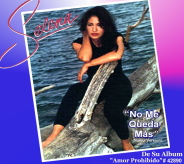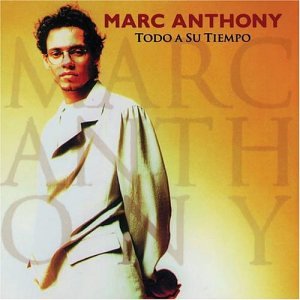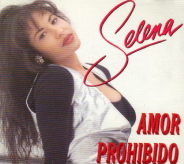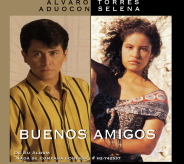
Amor Prohibido is the fourth studio album by American singer Selena, released on March 13, 1993, by EMI Latin. Having reached a core fan base, the label aimed to broaden her appeal with the next studio release. Finding it challenging to write a follow-up hit after "Como la Flor" (1992), Selena's brother A. B. Quintanilla enlisted the assistance from band members Ricky Vela and Pete Astudillo with writing the album's songs. The resulting album has a more mature sound featuring experimental production that blends diverse musical styles from ranchera to hip-hop music. Amor Prohibido is a Tejano cumbia album modernized with a synthesizer-rich delivery using a minimalist style that was quintessential in early 1990s Tejano music.

Segundo Romance is the tenth studio album by Mexican singer Luis Miguel, released on 30 August 1994 through WEA Latina. Like Miguel's 1991 album Romance, Segundo Romance comprises cover versions of boleros written between 1934 and 1993. It was produced by Miguel with Juan Carlos Calderón, Kiko Cibrian and Armando Manzanero and recorded in early 1994 at the Record Plant in Los Angeles.

Ones is a compilation album by American singer Selena, released in the United States on October 1, 2002 by EMI Latin. It was released on November 11, 2002 in Spanish-speaking countries, while the limited edition included a bonus DVD of her music videos. Ones was released building on the popularity of the 1997 biographical film Selena. The album was aimed at Selena's new generation of fans, and its release marked the singer's twentieth year in the music industry. Ones features six number one singles namely, "Amor Prohibido", "Bidi Bidi Bom Bom", "No Me Queda Más", "Fotos y Recuerdos", and her duets with Álvaro Torres on "Buenos Amigos" and the Barrio Boyzz on "Donde Quiera Que Estés".

"No Me Queda Más" is a song by American singer Selena on her fourth studio album, Amor Prohibido. It was released as the third single from the album in October 1994 by EMI Latin. "No Me Queda Más" was written by Ricky Vela, and production was handled by Selena's brother A.B. Quintanilla. A downtempo mariachi and pop ballad, "No Me Queda Más" portrays the ranchera storyline of a woman in agony after the end of a relationship. Its lyrics express an unrequited love, the singer wishing the best for her former lover and his new partner.

Todo a Su Tiempo is the second studio album by American recording artist Marc Anthony, released by RMM Records on May 31, 1995. The album was produced by Sergio George, who was also involved with production of Anthony's debut studio album, Otra Nota. The album comprises five new compositions, three of which were written by Omar Alfanno, and four cover versions. Eight singles were released from the album, all but one of which topped the Billboard Tropical Songs chart.

"Amor Prohibido" is the title song of American Tejano singer Selena's fourth studio album of the same name (1994). Released as the lead single through EMI Latin on April 13, 1994, it was written by Selena, her brother and music producer A. B. Quintanilla, and her band's backup vocalist Pete Astudillo. "Amor Prohibido"'s lyrical themes have been analyzed by authors, musicologists, and journalists, who found them relevant to issues facing the LGBT community. A popular interpretation compares it to Romeo and Juliet.

"Buenos Amigos" is a down-tempo, pop ballad duet recorded by Salvadoran recording artist Álvaro Torres and American recording artist Selena for Torres' sixth studio album Nada Se Compara Contigo (1991). The song was released by EMI Latin in 1992, as the album's second single. Its lyrics explore a friendship built on the strong, unrequited feelings of the male narrator. Torres composed "Buenos Amigos" after attending a showcase event at which Selena was performing.

"Si Una Vez" is a song recorded by American recording artist Selena for her fourth studio album, Amor Prohibido (1994). It was written by Pete Astudillo and produced by Selena's brother-producer A.B. Quintanilla. "Si Una Vez" is a mariachi fusion song and draws influence from cumbia and Latin dance music. Lyrically, Selena questions why she ever fell in love with an abusive partner, saying she will never repeat her mistakes. The lyrics suggest unrequited love and female empowerment.

"Donde Quiera Que Estés" is a duet recorded by American Latin pop quintet the Barrio Boyzz and American Tejano singer Selena. Released on the Barrio Boyzz' album of the same name, "Donde Quiera Que Estés" was written by K. C. Porter, Miguel Flores, Desmond Child, and produced by A.B. Quintanilla III, Domingo Padilla and Bebu Silvetti. The lyrics explore feelings felt after a breakup between first-time lovers who hope that their love will one day return. "Donde Quiera Que Estés" is a dance pop song with influences from hip-hop music.
American singer Selena released twenty-four official singles, seven promotional singles. Her career began as the lead vocalist of Los Dinos in 1980. Her albums with Los Dinos on indie labels failed to achieve any chart success. In 1987, her remake of Ritchie Valens' "La Bamba" peaked at number 19 on the United States Billboard Hot Latin Songs chart, her first entry. She signed with EMI Latin nine years later as a solo artist though her band continued to tour with her. Selena appeared on "Buenos Amigos" with Salvadoran singer Álvaro Torres. The track peaked at number one on the U.S. Hot Latin Songs chart in 1991, the singer's first number one song. Subsequent singles, "Baila Esta Cumbia" and "Como la Flor", became popular songs on Mexican radio, with "Como la Flor" launching the singer's career in that country. "Como la Flor" peaked at number six on the Hot Latin Songs chart, despite popular culture claims that it was the singer's first number one single. The track has charted on the U.S. Regional Mexican Digital Songs list since its inception in 2010 and remains the singer's signature number and most popular recording.

The Barrio Boyzz were an American Latin pop group. The group was made up of Puerto Ricans who grew up in New York City. They gained popularity during the 1990s, when they became label-mates with Selena Quintanilla then landed their first Billboard number-one song entitled "Donde Quiera Que Estés" in 1993, from the album of the same name.

"Amor" is a song written and performed by Mexican singer Cristian Castro and produced by Daniel Freiberg. It was released as the lead single for Castro's fourth studio album El Deseo de Oír Tu Voz in 1995 by Melody Records. It is an acoustic pop rock song in which the singer asks love to give him a chance. In the United States, it reached the summit of the Billboard Hot Latin Songs and spent 11 weeks at this position. In 1996, it ended as the second-best performing Latin song of the year in the country. "Amor" also reached number one on the Latin Pop Songs compiled by the same publication. A music video for "Amor" was filmed in Rome, Italy and directed by Castro, featuring the artist performing various stunts in the city.
The discography of American Latin rap band The Barrio Boyzz consists of seven studio albums, five compilation albums, one holiday album, fourteen singles and four music videos. The Barrio Boyzz was formed in 1991 by Joe Jacket, who proposed creating a mainstream Latino group. They auditioned for chairman of EMI Records, Charles Koppelman, who signed the group to its sister label SBK Records. The group's debut album, Crazy Coolin' (1992), failed to make any impact on music charts, but its lead single "Muy Suavemente" peaked at number 36 on the US Billboard Hot Latin Tracks chart. Their second studio album, Donde Quiera Que Estes (1994) reached the top 20 on Billboard's Latin charts. The album spawned three singles; "Cerca De Ti" and "Te Amaré", which peaked at number one and number 16 on the Hot Latin Tracks, respectively. The titular single, a duet with American Tejano pop singer Selena, peaked at number one and was logged atop the Hot Latin Tracks chart for six consecutive weeks.

"Mañana, Mañana" is a song written by Mexican singer-songwriter Juan Gabriel. Argentine singer Libertad Lamarque performed the song in the Mexican movie La loca de los milagros. Juan Gabriel released his recording of the song, a duet with Estela Nuñez, on his album Ella (1979). The song describes the departure of a lost love who will never return.
"Detrás de Mi Ventana" is a Latin pop song by Mexican recording artist Yuri from her studio album Nueva Era (1993). The track was written by Guatemalan singer-songwriter Ricardo Arjona. It was released as the lead single in Latin America and the United States, peaking atop the Billboard's Latin Songs chart, becoming the third number-one song in the chart for the singer and the first for Arjona as a songwriter.

"Vuélveme a Querer" is a song written and produced by Jorge Avendaño Lührs and performed by Mexican recording artist Cristian Castro for the compilation album Boleros: Por Amor y Desamor (1995). The song speaks of a protagonist who yearns for his lover to return. In the United States, the song peaked at number two on the Billboard Hot Latin Songs and number one on the Billboard Latin Pop Songs chart. It received a Billboard Latin Music Award and a Lo Nuestro nomination for Pop Song of the Year the following year. Avendaño received an award in the Pop/Rock category at the American Society of Composers, Authors and Publishers (ASCAP) Awards of 1997

"No Sé Olvidar" is a song written by Kike Santander and performed by Mexican recording artist Alejandro Fernández. It was co-produced by Santander and Emilio Estefan and was released as the third single from Me Estoy Enamorando by Sony Music Mexico in 1997. The song is a bolero-pop ballad with ranchera influences and portrays the singer desperately trying to forget his lover. A music video was made for the track which features Fernández hopelessly attempting to not remember his lover only to slowly delve into insanity. It received a nomination for Video of the Year at the 1998 Lo Nuestro Awards.
"Ámame una Vez Más" is a song performed by Amanda Miguel on her 1996 studio album of the same name. It was co-written by Anahí and produced by her husband Diego Verdaguer. The album remarked the return of Amanda Miguel following more than a five-year hiatus. "Ámame una Vez Más" won the Billboard Latin Music Award for Latin Pop Song of the Year in 1997 and was recognized as one of the award-winning songs at the ASCAP Latin Awards in the same year. It was also nominated for Pop Song of the Year at the 8th Annual Lo Nuestro Awards in 1997.
"Te Amaré" is a song performed by Latin pop boy band The Barrio Boyzz and written by one of its band members, Angel Ramirez, on their second studio album Donde Quiera Que Estés (1993). It peaked at number 16 on the Hot Latin Songs chart.















